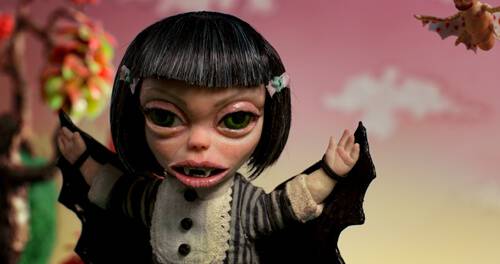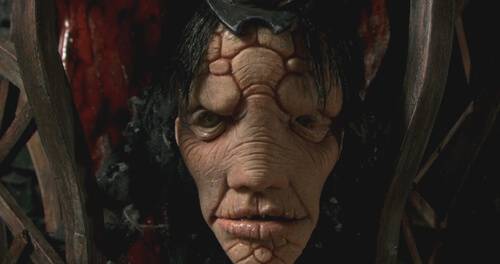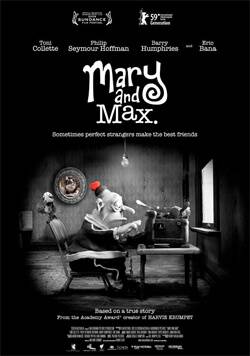“Butterflies” – Q&A with Warwick Burton & Isabel Peppard
UPDATE (23/02/2021) – Butterflies is now available to watch online in full via Omeleto.
Butterflies is a stop-motion horror-fairytale from Australia that has been picking up worldwide attention since its festival debut last year. Having been described by Sitges as being “destined to become an instant stop motion classic”, we at Skwigly can’t agree more. Making full use of stop-motion’s ability to deliver warmth, magic, unease and terror in equal measure, Butterflies tells a story that, at its core, is inherently relatable to all who’ve worked in the creative industries. We checked in with writer/producer Warwick Burton and writer/director Isabel Peppard to find out more.
The pair of you have been working together since (I believe) 2006. How did you come across one another and what was it about each other’s work that made it seem a creative fit?
Warwick Burton: Isabel and I met on the set of a kids’ music video series that I was directing. We spoke about animation then spent the best part of a year pursuing a project together, which eventually became Gloomy Valentine. When we met about 2004, I was not long out of film school, and Isabel was working in effects and make up. We both want to make animation, and I think we realized that we could compliment each other’s skills working on a project together.
Isabel Peppard: It was a bit of a happy coincidence. I didn’t have a lot of experience as an animation director but I had an idea (Gloomy Valentine) that I was very passionate about. I actually did a very brief verbal pitch to Warwick on the set of this DVD that we were both working on and I remember him saying something along the lines of “sounds great, I’ll produce it!”
It was a real leap of faith on both of our behalves but it seems to have worked out pretty well.
At that point how long had you both been working in the industry respectively, and in what areas? Has your collaborative work been a detour from what came before?
WB: I’d been working in the film industry in NZ since 1998 and in Australia from 2001. Prior to 1998 I had made half a dozen films in Dunedin, NZ that were mostly direct animation / experimental films. In that sense, working with Isabel has been a natural expansion of my creative interests. I also worked as a producer and director of factual programs and had worked in the documentary commissioning team at SBS Television in Australia. Although animation and documentary are obviously very different forms of storytelling, I don’t think of either as a detour because at heart both rely on “a good story well told.”
IP: I’d been working in special fx and stop-motion animation for about 5 years at that point. I didn’t really ever consider becoming a director, it’s just that I had this idea that started gnawing away at me. It was an idea accompanied by imagery that just kept appearing in my brain. I felt quite driven to make it happen.
What were the circumstances that led to the production of your first short Gloomy Valentine?
WB: Isabel had an idea to make a film inspired by the work of the Hungarian composer Rezső Seress called “Gloomy Sunday.” We began working on this and eventually received the support of the Australian Film Commission and were able to produce the film. At the time Isabel was living in a huge warehouse so we were able to produce the film there in a small studio lined with black builders plastic. It was dusty and hot… poor Izzy spent all her days and nights there. The conditions were similar to what an industrial revolution factory might have been – perhaps it subconsciously inspired some of the ideas in Butterflies!
IP: We actually had a few funding knock backs but continued to develop the project over the years. By the time we did receive funding, Gloomy was quite developed. We had part of a set, the main character and a whole bunch of test footage up our sleeve to help build our case.
As far as approaching/executing Butterflies, what were the main lessons and experiences from your first short that you benefited the most from?
WB: There were so many things that we learned from making Gloomy Valentine that somehow informed our approach in making Butterflies.
I think we both learned a great deal about collaborating together on the story for Gloomy – and that made it easy to work closely together on the script of Butterflies.
Working with the Australian Film Commission was another good experience. We had a very supportive development manager and she has continued to support Isabel and I since then too. Butterflies was financed by Screen Australia and we had a similarly positive experience.
Technically, our approach on Gloomy Valentine was challenging and probably a bit risky. Digital shooting with ‘prosumer’ gear was still quite a new thing. The technology has made huge leaps forward since 2005. When we edited Gloomy in 2K, it was a challenge for the edit suite to cope with. Now you can easily edit in 2K on your laptop!
Many of the crew members who worked on Gloomy Valentine also worked on Butterflies. Having their expertise the second time around and being able to draw on their skills had a tangibly beneficial effect on the production aspects of Butterflies.
IP: I think learning to collaborate and developing a team was a great lesson from Gloomy. To be honest, Butterflies was a bit of a game changer for me in terms of the scale of the whole production. Even thought I learnt certain things on Gloomy, the process of making Butterflies was quite different. I had new software, a different style of camera, different puppet making techniques and a bigger crew and budget. Needless to say, I had to learn a lot on my feet!

Claire as a Vampire
The main premise of the film seems built on the tragedy of letting one’s creativity erode and the fear of it dying off altogether, something familiar to most in any creative industry who’ve either witnessed it or experienced it firsthand. What was it about this subject that personally compelled you to explore it with the film?
WB: I’m interested in telling stories that touch people emotionally. I do look for universality in the stories that I tell. Butterflies has a universality that I hope is not limited to just creativity – for me it is about the decision to give up doing something you love doing – something that makes you who you are – in pursuit of money, stability, or just pursuit of the ‘dream’ of having a better life – when the truth is that your life is better when you do what you love. I think there is a balance – having no money and loads of time is not much fun if you can’t do what you love doing. But conversely, you’ve lost out if you spend all of your time working to get money to do the things you love – but have no time to do it. As I grow older and have different responsibilities I think I realize that the balance is very difficult to strike.
I’d explored a similar theme in a previous short film that I directed called One Fine Day, but the story idea for Butterflies was worked up from a series of notes & ideas that Isabel had made.
IP: For me the story of Butterflies is really autobiographical. I have always been a compulsively creative person with all different projects and ideas on the go. Because I have technical skills I ended up working full time on commercial projects for about 3 years. During this period I became very depressed and really had the tangible feeling that I was losing a part of myself. Until this point, I hadn’t realised how much artistic expression fed into my self esteem and my feeling of place in the world. Luckily, working in conjunction with Warwick, I was able to take this horrible emotional experience and turn it into a story. So, for me, Butterflies was a redemptive example of art imitating life.
Being at the helm of the project, to what degree were you involved in the design and hands-on creation/animation of the puppets themselves?
IP: I was the production designer on Butterflies and heavily involved in building all the sets and characters in the film. I sculpted all the key characters, did a lot of the moulding, casting, painting etc. Me and my partner Beau White did a lot of the work so we were essentially in a small workshop together for a year and a half! I also set up and ran the workshop and engaged all the pre-production/ animation crew as I had worked with a lot of them on other projects so I really knew their skill sets. In terms of animating, I probably animated a third of the film myself. As I generally work my way from thematic visuals into a story, the design elements are incredibly important to me. I also believe in being as hands on as possible so I can really put a lot of myself into my projects.
The material used for the characters goes a long way to give them a lifelike, organic quality. Was the use of silicon as opposed to other stop-motion options a stylistic choice or a practical one?
IP: I have a real love for the fleshy, visceral quality of silicone so it was probably firstly a stylistic choice. In terms of the practicality it was easier for me to have faces with movement than to work with a lot of replacement facial features. I also have a long history working silicone in SPFX and commercial art, I guess I was playing to my strengths in a way. That being said, I still had to do months of R&D finding the right type of silicones and getting paint to stick!
The design for Dalton Hearst, arguably the ‘villain’ of the piece, ranks up there as one of the more unsettling character designs in stop-motion history (which sees it up against some stiff competition). Was it important to push the look of the character in such a nightmarish direction?
IP: The story of Butterflies has a real Faustian theme running through it. The main character sells a piece of her soul for money and then has to deal with the repercussions of her action. This idea really fed into the design of Dalton and his overall character.

Dalton Hearst in his booth
The use of horror and fantasy elements in animated stories seem to be far more effective when implementing stop-motion than with CG or 2D. Why do you suppose this is, and has this contributed to your gravitating more toward stop-motion than other animation mediums?
IP: I’ve always gravitated towards stop-motion as that’s where my skill base is. I’m also predominately a horror/fantasy director so for me it’s just lucky that the two go hand in hand.
WB: I think that creating a world using stop motion techniques brings a veracity that is very difficult to match with 2D animation (unless you have a fairly large budget). The ‘hand made’ nature of stop motion also probably lends to its ability to tell ‘fairytales’ that seems somehow imbued with ‘history.’ I personally love animation because it is magic. You start with some inanimate objects and magically bring them to life, give them emotions, make them talk… it really is magic, wonderful magic!
The ‘horror’ aspect of the film, though tonally present throughout, really kicks into gear during the nightmare/fantasy sequence near the end. Where there any particular directorial – or artistic – influences for this sequence?
IP: The nightmare/fantasy sequence is essentially a psychological landscape, a hell at the end of dreams. Here she sees the grotesque embodiments of her co-workers trapped in personal purgatory after giving up on their creative practice. Outside of the conceptual nature of the scene, I didn’t have a lot of conscious influences directorially. Aesthetically, I saw it as a sort of slum of the mind and therefor drew a lot of design influences from shantytowns and slums. We were low on budget at the time as this was the last set so Beau and I ended up scavenging a lot of the materials from the street and used the weathered qualities of the aged wood to inform the colour and texture of the set.
Throughout production you kept up a blog documenting your progress, supplementing the main website for the film. Have you found having this type of web presence is useful for building up anticipation for a film, garnering feedback etc?
IP: I think it is very helpful to put your work out there. We have been approached by many festivals and media types based on our online presence.
WB: Yes, I think it should be mandatory for all short films to keep a blog! I unreservedly recommend it. It also becomes a really useful archive of the things that happened during production, and over the production period, it is really useful just to let people know what is going on. We’ve also used Facebook and Twitter to connect with people interested in the film. Each attracts a different crowd, so I think they compliment each other.
From reading the blog it seemed that casting and recording the performers for the film actually came after the animation itself. Even considering that it’s largely narrated, this approach seems somewhat atypical, was there any particular reason it was done this way around?
WB: We wanted to be able to secure really fantastic voice talent for the short, but knew that doing this at script stage would have been very difficult to achieve. So, we decided to wait until we had shot and edited the story. It was a risk in some way, but the actors actually brought amazing life and energy to the characters. Nicholas Hope was positively bloodcurdling!
IP: We felt that if we had solid visual material, it would be easier to convince the talent that we wanted to get on board. The cast was fantastic! I particularly love the dark earthy qualities of Rachel Griffiths’ voice.
 Your (Isabel’s) prior animation experience includes Adam Elliot’s tremendous feature Mary and Max, what were your main roles on that project and how do you feel the work you’re doing now has benefited from it?
Your (Isabel’s) prior animation experience includes Adam Elliot’s tremendous feature Mary and Max, what were your main roles on that project and how do you feel the work you’re doing now has benefited from it?
IP: I had a bunch of roles on Mary and Max but I was mainly in the puppet department. I think my credits on the film are mouldmaker, sculptor, character painter and set decorator. I really learnt so much about stop-motion animation working on Mary and Max, it was a hugely valuable experience. It was also a great pleasure working with Adam and seeing him tackle such a huge production (by Australian standards) with such grace and fortitude.
Despite its obvious strengths as a feature, Mary and Max ultimately didn’t seem to pick up the distribution it deserved. What were your impressions of how the film (and, by extension, the independent and animated film scene) was received in Australia?
IP: I felt that it was very well received in Australia and seemed to be critically embraced internationally. It seems to be a film that continues to find an audience even so long after its release, almost a sort of cult film. In terms of distribution, I’m not entirely sure of the facts and figures but I think its always harder distributing feature animation for adults.
Further to the previous question, how do you feel the Arts – in particular shorts and animation – are regarded in Australia these days? Are there many opportunities open for emerging filmmakers or is getting funds together more of a struggle?
IP: I would say that the overall attitude to the arts in Australia isn’t as supportive as other parts of the world. There is definitely an element of the population that thinks it’s a waste of taxpayers money supporting the arts! Australia has a huge pool of talent (especially in animation) but there certainly are limited funding opportunities. Luckily crowd funding is changing the game to some degree. Although it would be hard to raise the full budget for a short animation, I think you could definitely raise enough to get the ball rolling.

Warwick Burton & Isabel Peppard at Sydney Film Festival launch (holding the Award for Best Animated Short, awarded at Cinequest Film Festival 2013)
Depending on who you ask there seems to have been something of a stop-motion resurgence in the past couple of years, especially with features. Would a longer-form project be appealing to you at this stage, and if so would you continue to work together?
IP: Personally, I’m more interested in live action horror with animated elements than making a stop-motion feature. Even though its not financially rewarding, I really prefer the short form when it comes to stop-motion. It’s like a poem as opposed to a novel. I’m sure if a project came along that we were both interested in, me and Warwick would get the old gang back together!
WB: Yes – definitely if the right project came along we would work together again.
Butterflies will be screening next week at the prestigious Annecy Festival. For more information on upcoming screenings and behind-the-scenes insight visit the film’s official website.
Items mentioned in this article:
![Gloomy Valentine[NON-US FORMAT, PAL]](https://www.skwigly.co.uk/wp-content/uploads/2013/06/Gloomy-Valentine-DVD.jpg)

